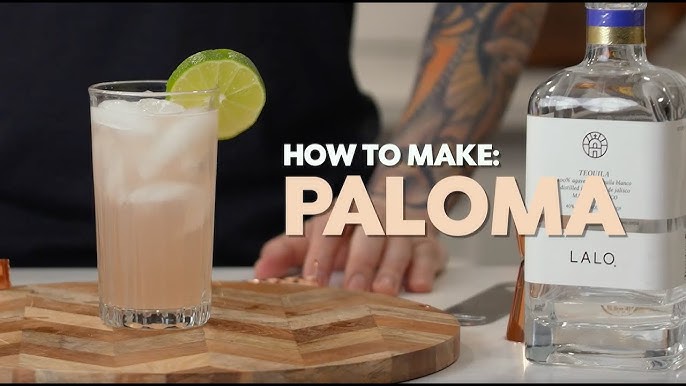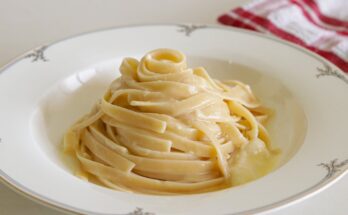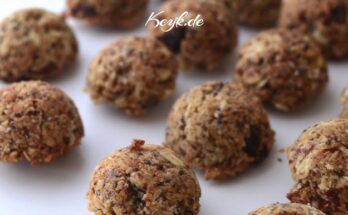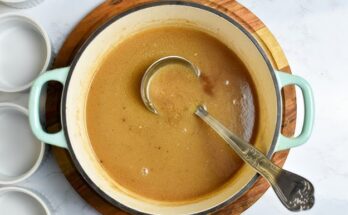Paloma Drink Recipe: When it comes to refreshing cocktails that scream summer, the Paloma is often the unsung hero. Overshadowed by the ever-popular Margarita, the Paloma deserves more attention. It’s fizzy, citrusy, slightly bitter, and packed with the tangy punch of grapefruit — all balanced perfectly with the rich character of tequila. Whether you’re lounging poolside or hosting a casual gathering, the Paloma is your go-to drink for easy sophistication. In this guide, we’ll walk you through everything you need to know about this refreshing cocktail, from its roots to mixing the perfect glass.
So, if you’ve been looking for a drink that’s crisp, easy to make, and loaded with flavor, this Paloma recipe will soon be your favorite. Let’s get into it.
What is a Paloma?
A Paloma is a popular Mexican cocktail that combines tequila, grapefruit soda, and lime juice. It’s served over ice in a highball or Collins glass and typically garnished with a wedge of lime or a salted rim. The word “Paloma” translates to “dove” in Spanish, giving the drink a gentle, romantic name that mirrors its delicate balance of sweet, sour, and salty.
Unlike the Margarita, which uses triple sec and lime as its base, the Paloma relies heavily on the bitter citrus profile of grapefruit. The result is a lighter, more refreshing cocktail that feels less boozy and more drinkable — making it perfect for casual sipping throughout the day. Its versatility and low-alcohol feel are what make it beloved across Mexico and increasingly, the world.
The magic of the Paloma lies in its simplicity. Just a few ingredients, no complex techniques, and boom — you’ve got a world-class drink in your hand.
History and Origin of the Paloma Drink
Though it’s one of Mexico’s favorite cocktails, the Paloma’s origin story is somewhat murky. Unlike many iconic cocktails that have documented histories and famous creators, the Paloma remains something of a mystery.
One common theory is that it was created in the mid-20th century by Don Javier Delgado Corona, the owner of La Capilla, a legendary bar in Tequila, Mexico. However, there’s little hard evidence to confirm this. Some speculate the name and recipe emerged organically from the mix of ingredients readily available in Mexico at the time — particularly the introduction of grapefruit soda, like Squirt, in the 1930s and 40s.
Regardless of its exact roots, the Paloma has become a staple in Mexican cocktail culture. It’s often seen as the drink of the people, more down-to-earth and accessible than its glamorous cousin, the Margarita. The simplicity and refreshment it offers make it a go-to choice for hot days, family gatherings, and celebratory toasts.
Today, the Paloma is enjoyed worldwide, often with creative spins and regional twists — but its heart remains in the streets and cantinas of Mexico.
Ingredients You Need for a Classic Paloma
To create the perfect Paloma, you’ll need just a few fresh ingredients. Simplicity is part of this cocktail’s charm, so there’s no need to stock an entire bar. Here’s what you’ll need:
The Key Components
- Tequila: Use a good quality blanco (silver) tequila. It’s smooth, clean, and blends well with the tangy grapefruit flavor. Don’t skimp on this — the better the tequila, the better the drink.
- Grapefruit soda: Traditional recipes use Mexican grapefruit sodas like Jarritos or Squirt. These sodas have a lighter, less sugary taste than typical American sodas.
- Fresh lime juice: A squeeze of lime brings brightness and balances the sweetness of the soda.
- Salt: For rimming the glass — optional but highly recommended. It enhances the flavor and gives a nice edge with every sip.
- Ice: Crushed or cubed, ice is essential for that chill factor.
Optional Garnishes and Enhancements
- Lime wedge or grapefruit slice: A touch of citrus on the rim or floating in the drink adds visual appeal and a hint of extra aroma.
- Tajín seasoning: For a spicy-salty rim, swap the plain salt for Tajín.
- Simple syrup or agave nectar: If you prefer a slightly sweeter drink, a small splash will do the trick.
- Herbs like rosemary or mint: These can add a fancy flair for more upscale presentations.
Now that you know what you need, let’s look at the tools to mix it up properly.
Tools and Glassware Needed
Making a Paloma doesn’t require a full bartender’s toolkit, but a few essentials will help ensure the best flavor and presentation.
Cocktail Tools for the Perfect Mix
- Jigger or measuring tool: Precision matters, even in simple cocktails. A jigger helps ensure your tequila-to-soda ratio is just right.
- Citrus juicer or reamer: Fresh lime juice is non-negotiable. A handheld citrus squeezer makes it easy.
- Bar spoon: For stirring your cocktail gently. You don’t want to lose the soda’s fizz.
- Salt rimmer or small plate: To rim your glass with salt or Tajín, use a shallow dish or dedicated rimmer.
Best Glasses for Serving Palomas
- Highball glass: Tall and slender, the highball is perfect for fizzy cocktails like the Paloma.
- Collins glass: Slightly narrower but still tall, the Collins glass also works well.
- Clay copita (optional): In Mexico, Palomas are sometimes served in clay cups, which keep the drink cooler longer and add an earthy element to the experience.
Whether you’re going traditional or modern, a good vessel makes a big difference.
Step-by-Step Guide to Making a Paloma
Ready to craft the ultimate Paloma? Let’s walk through it step by step so you can create a refreshing, bar-quality cocktail at home with ease. Whether you’re a seasoned mixologist or a complete beginner, these steps will have you sipping a perfect Paloma in no time.
Step 1 – Prepare Your Ingredients
Preparation is key. Start by gathering all your ingredients and tools. Wash your citrus fruits thoroughly, especially if you’re using them as garnishes. Cut a lime into wedges for rimming and juicing. If you’re planning on using fresh grapefruit juice instead of soda, go ahead and juice that as well.
Here’s a quick prep checklist:
- Cut your lime into wedges and squeeze out the juice
- Rim your glass (if desired) with lime juice and dip it into salt or Tajín
- Chill your glass in the freezer while you prep the rest
- Measure out 2 oz of tequila (blanco or reposado)
- Have your grapefruit soda or fresh juice ready to pour
This might sound like a lot, but it all takes less than five minutes and makes a huge difference in the drink’s quality.
Step 2 – Mix the Drink
Start by filling your prepared glass about halfway with ice. Add the tequila first—this is your base, the heart of the drink. Then, pour in about 0.5 to 1 oz of fresh lime juice depending on your taste preference. If you’re using simple syrup or agave, now’s the time to add a splash.
Give it a gentle stir to blend the tequila and lime juice. You’re aiming for balance — not overpowering the tequila but keeping it crisp and citrusy.
Next, top it off with about 3 to 4 oz of grapefruit soda. Pour slowly so you don’t lose too much carbonation. Stir gently just once or twice to incorporate without flattening the soda.
That’s it — your drink is almost ready to serve.
Step 3 – Add the Ice and Soda
If you haven’t already, add a few more cubes of ice to top off your glass. You want the drink chilled but not overly diluted. The grapefruit soda should remain fizzy, so avoid aggressive stirring.
Using high-quality ice matters more than you might think. Clear, hard ice melts slower and keeps your Paloma tasting fresh from the first sip to the last.
If you’re feeling fancy, you can use large clear ice cubes or spheres, which look beautiful and enhance the sipping experience.
Step 4 – Garnish and Serve
Time to make it look pretty! A well-garnished drink isn’t just for looks—it adds aroma and elevates the entire drinking experience.
- Lime wedge: Classic and simple. Add it to the rim or drop it in the drink.
- Grapefruit slice: A colorful touch that complements the drink’s flavors.
- Herbs like rosemary or mint: These can enhance the smell and add an elegant twist.
Serve immediately with a straw or a stirring stick if desired. Sip slowly and enjoy the crisp, fizzy, citrus-kissed refreshment that is the Paloma.
Whether you’re drinking solo or entertaining guests, this cocktail is a crowd-pleaser that’s as easy to make as it is enjoyable to drink.
Tips for the Perfect Paloma Every Time
- Choose quality tequila: Always opt for 100% agave tequila—blanco is traditional, but reposado adds a richer depth.
- Fresh is best: Fresh lime juice makes a noticeable difference over bottled.
- Balance your sweetness: If using fresh grapefruit juice, consider adding a splash of simple syrup or agave.
- Chill everything: From your glass to the soda, keeping ingredients cold ensures the drink stays crisp.
- Don’t over-stir: A gentle swirl is all you need after adding soda—preserve that fizz!
Want to switch it up next time?
Common Variations of the Paloma Cocktail
The Paloma is endlessly customizable. Here are a few fun ways to change it up and impress your friends—or just treat yourself.
Spicy Paloma
Love a little heat? Muddle a slice of jalapeño or use chili-infused tequila. You can also rim the glass with Tajín for a tangy-spicy twist. This version is bold and fiery, perfect for spice lovers who enjoy a kick with their sip.
Smoky Mezcal Paloma
Replace the tequila with mezcal for a smoky, earthy variation. Mezcal’s complex character pairs beautifully with grapefruit, creating a deeper, more intriguing flavor profile. It’s not for everyone, but mezcal fans will find this irresistible.
Paloma Mocktail for Non-Drinkers
Skip the tequila and use club soda or non-alcoholic spirits for a booze-free version. Keep the lime and grapefruit elements, and you still have a refreshing, flavorful drink that everyone can enjoy. You can even add a dash of bitters for complexity.
Pairing Food with a Paloma
One of the joys of the Paloma is its versatility—not just in how you can make it, but in how well it pairs with food. Thanks to its light, citrusy profile and fizzy texture, the Paloma is a wonderful companion to a variety of dishes. If you’re planning a menu around your drinks, here’s how to make the most of it.
Mexican Cuisine: A Natural Fit
Let’s start with the obvious: Mexican food and Palomas go hand in hand. The grapefruit and lime in the drink cut through rich and spicy flavors beautifully, making it a great match for tacos, enchiladas, tamales, and even street food like elote (Mexican street corn).
- Tacos al pastor: The sweet and savory pork, paired with pineapple and onions, gets a refreshing balance from the tangy Paloma.
- Ceviche: The citrusy, chilled seafood dish amplifies the grapefruit notes and keeps the palate clean.
- Nachos or guacamole: Lighter fare that pairs well with the drink’s acidity and effervescence.
Grilled Meats and BBQ
The Paloma’s acidity and carbonation help it stand up to hearty, grilled flavors. Consider it alongside:
- Grilled chicken or steak: The tequila base complements smoky meat flavors.
- BBQ ribs: A surprisingly good match, the citrus element acts like a reset button between bites.
- Chorizo or spicy sausages: The cocktail cools the heat and adds a refreshing contrast.
Vegetarian and Light Fare
Even lighter dishes aren’t overshadowed by the Paloma. Salads with citrus vinaigrettes, grilled veggies, or quinoa bowls benefit from the cocktail’s light touch. Think of it like adding a bit of brightness to your meal—zippy, clean, and incredibly palate-friendly.
Whether you’re throwing a backyard barbecue or enjoying a casual taco night, the Paloma enhances your food in a way few cocktails can. It’s truly the drink that goes with everything.
FAQs about Paloma Drink Recipe
1. Can I use fresh grapefruit juice instead of grapefruit soda?
Yes! You can substitute fresh grapefruit juice and top it off with club soda for a more natural, less sweet drink. You may want to add a touch of simple syrup or agave to balance the tartness.
2. What type of tequila works best in a Paloma?
Blanco tequila is the traditional choice for its clean, crisp flavor, but reposado tequila adds depth with its oak aging. Choose 100% agave tequila for the best taste.
3. How can I make a Paloma less bitter?
If the grapefruit flavor is too strong or bitter for you, consider using a grapefruit soda with added sugar, or add a splash of orange juice or agave syrup for sweetness.
4. Is the Paloma stronger than a Margarita?
Not necessarily. A Paloma typically has less alcohol per volume because it’s topped with soda. Margaritas often have more concentrated alcohol from both tequila and orange liqueur.
5. Can I batch-make Palomas for a party?
Absolutely! Mix tequila, lime juice, and grapefruit soda in a pitcher (without ice), and serve over ice when guests arrive. Keep garnishes on hand for a festive presentation.
Conclusion
The Paloma is more than just a refreshing cocktail—it’s a celebration in a glass. With its origins rooted in Mexican tradition, its simple ingredients, and endless adaptability, this drink checks all the boxes. It’s light enough to sip all afternoon, bold enough to hold its own with food, and easy enough for anyone to master.
Whether you prefer it spicy, smoky, or non-alcoholic, the Paloma can be tailored to your taste with minimal effort. All it takes is quality tequila, zesty lime, and the bittersweet charm of grapefruit soda to transport your tastebuds straight to a sun-soaked patio in Mexico.
So the next time you’re in the mood for something fun, fresh, and full of flavor, reach for the Paloma. It might just become your new favorite cocktail.



